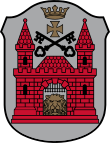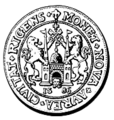
The coat of arms of Belgium bears a lion or, known as Leo Belgicus, as its charge. This is in accordance with article 193 of the Belgian Constitution: The Belgian nation takes red, yellow and black as colours, and as state coat of arms the Belgian lion with the motto UNITY MAKES STRENGTH. A royal decree of 17 March 1837 determines the achievement to be used in the greater and the lesser version, respectively.
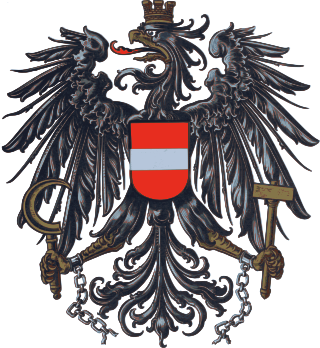
The current coat of arms of the Republic of Austria has been in use in its first forms by the First Republic of Austria since 1919. Between 1934 and the German annexation in 1938, the Federal State used a different coat of arms, which consisted of a double-headed eagle.

The coat of arms of Bulgaria consists of a crowned golden lion rampant over a dark red shield; above the shield is the Bulgarian historical crown. The shield is supported by two crowned golden lions rampant; below the shield there is compartment in the shape of oak twigs and white bands with the national motto "Unity makes strength" inscribed on them.
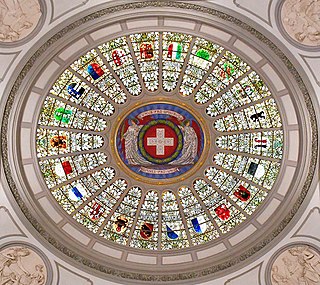
Each of the 26 modern cantons of Switzerland has an official flag and a coat of arms. The history of development of these designs spans the 13th to the 20th centuries.

The coat of arms of Finland is a crowned lion on a red field, the right foreleg replaced with an armoured human arm brandishing a sword, trampling on a sabre with the hindpaws. The coat of arms was originally created around the year 1580.

The city of Kraków uses a coat of arms, a seal, official colors, a flag, and a banner as its official symbols. Additionally, a number of semi-official and unofficial symbols of the city are also used.

The coat of arms of Romania was adopted in the Romanian Parliament on 10 September 1992 as a representative coat of arms for Romania. The current coat of arms is based on the lesser coat of arms of interwar Kingdom of Romania, which was designed in 1921 by the Transylvanian Hungarian heraldist József Sebestyén from Cluj, at the request of King Ferdinand I of Romania, it was redesigned by Victor Dima. As a central element, it shows a golden aquila holding a cross in its beak, and a mace and a sword in its claws. It also consists of the three colors which represent the colors of the national flag. The coat of arms was augmented on 11 July 2016 to add a representation of the Steel Crown of Romania.

The coat of arms of Poznań consists of white city walls with three towers. On the left (heraldic) tower stands Saint Peter with a key and on the heraldic right one stands Saint Paul with a sword. In the gate there are two golden crossed keys with a cross above. Over the middle tower, which contains a single window and is topped by a battlement, there is a gothic shield with a white eagle in crown. On the sides of the two saints there are golden crescents and stars. All of those elements are on a blue field. Over the shield there is golden crown. Author of modern version of coat of arms is Jerzy Bąk.

The coat of arms of Malta is the national coat of arms of the country of Malta.

The coat of arms of Belgrade is the official symbol of the City of Belgrade and is stable in three levels - as Basic or Small, Medium and Large.

The Coat of arms of the Republic of Latvia was officially adopted by the Constitutional Assembly of Latvia on 15 June 1921, and entered official use starting on 19 August 1921. It was created using new national symbols, as well as elements of the coats of arms of Polish and Swedish Livonia and of the Duchy of Courland and Semigallia. Thus, the coat of arms combines symbols of Latvian national statehood, as well as symbols of its historical regions. The Latvian national coat of arms was designed by the Latvian artist Rihards Zariņš.

The coat of arms of Denmark has a lesser and a greater version.
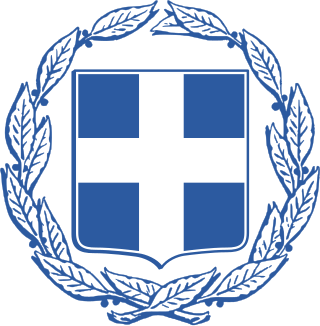
The coat of arms of Greece or national seal of Greece comprises a white Greek cross on a blue escutcheon, surrounded by two laurel branches. It has been in use in its current form since 1975. Prior to the adoption of the current coat of arms, Greece used a number of different designs, some of which were not heraldic; the first heraldic design was introduced in 1832 and its main element, the blue shield with the white cross, has been the base for all other national coats of arms since then. The design is a heraldic representation of the Greek national flag adopted in 1822, which featured a white cross on a blue field.

The current coat of arms of Timișoara was adopted in 1995 and modified in 2009.

The coat of arms of the German state and city of Hamburg is a kind of national emblem. The coat of arms and the flags are regulated by the constitution of Hamburg and law. The colors of Hamburg are white and red. One of the oldest versions of the castle is found on a seal in 1241.

Coat of arms of Tallinn represents Tallinn, the capital city of Estonia.

Attributed arms are Western European coats of arms given retrospectively to persons real or fictitious who died before the start of the age of heraldry in the latter half of the 12th century. Once coats of arms were the established fashion of the ruling class, society expected a king to be armigerous. Arms were assigned to the knights of the Round Table, and then to biblical figures, to Roman and Greek heroes, and to kings and popes who had not historically borne arms. Each author could attribute different arms for the same person, but the arms for major figures soon became fixed.

The heraldic ensigns of the Ministry of Internal Affairs consist of the following elements: large blue shield with a crusader golden eagle, having its head turned to the right, red peak and claws, open wings, holding a silver sword in its right claw; the green olive branch, symbolizing peace and order, replacing the mace from the coat of arms of the country; the small shield, placed on the eagle's chest, having five sectors which symbolize the most important structures of the ministry; at the bottom of the external shield, on a white scarf, the motto of the ministry is written in black: Latin: PRO PATRIA ET ORDINE IURIS, meaning "For the country and for the lawful order". The first sector represents the General Inspectorate of Romanian Police, the second sector includes the heraldic ensigns of the General Inspectorate for Emergency Situations, the third sector contains the ensigns of the General Inspectorate of Border Police, the fourth sector represents the General Inspectorate of Romanian Gendarmerie, the fifth sector represents the Administration, and the sixth sector contains the emblem of the National Archives.

The coats of arms of the Holy See and Vatican City in the form that combines two crossed keys and a tiara used as a coat of arms of the Holy See have origins attested from the 14th century. The combination of one gold and one silver key is a somewhat later development.

The flag of Riga is one of the official symbols of Riga, along with the coat of arms of Riga.

